What’s Up?
A large cloud on the eastern horizon on Sunday morning eliminated any chance of sunrise color. And there was little ground fog. Those conditions turned out to be a blessing. Everything was slightly backlit with the sun in front of me (albeit behind the big dark cloud). As dozens of wading birds flew in, it turned into what I call a “pewter” situation: the world became a beautiful matrix of semi-silhouetted wading birds in various shades of silver and lead-grey.
As you will learn below, my success that morning was limited due to a mind-set. My mind-set. 🙁
Working with the R5 for the first time in nearly a month was very frustrating. It is a complex camera body with complex menus. I spent several hours beforehand going through and setting the various menus. I used the R5 e-Guide (in progress) to help me along the way. Despite that, I found that I was unable to have the camera do what should have been the relatively simple thing that I wanted it to do. The new e-Guide will be much better for it. I will be working on it in earnest from Wednesday on.
BTW, the phrase “Hell in a handbasket” might have evolved during the California gold rush of 1848. Miners were lowered by hand in baskets down mining shafts to set dynamite. If there was a problem or if they did not get out quick enough, it was referred to as going to Hell in a handbasket.
Today is Monday 1 February (where did January go???) 2021. The forecast for my last morning at the refuge in Titusville is calling for very cloudy with the wind from the west. (It did rain last night.) The possibility for another pewter morning exists as long as it is fairly still early on … Whenever you have a morning with west or northwest winds, you should be praying for clouds to avoid the dreaded wind-against-sun conditions.
This blog past makes forty-three days in a row with a new blog post. This one took more than two hours to prepare. Please remember …
Please Remember
With income from IPTs now at zero, please, if you enjoy and learn from the blog, remember to use one of my two affiliate programs when purchasing new gear. Doing so just might make it possible for me to avoid having to try to get a job as a Walmart greeter and will not cost you a single penny more. And if you use Bedfords and remember to enter the BIRDSASART code at checkout, you will save 3% on every order and enjoy free second-day air shipping. In these crazy times — I am out at least forty to sixty thousand dollars so far due to COVID 19 (with lots more to come) — remembering to use my B&H link or to shop at Bedfords will help me out a ton and be greatly appreciated. Overseas folks who cannot order from the US because of import fees, duties, and taxes can always help out by clicking here if they see fit.
The BAA Used Gear Page
The Used Gear page continues to be very active. The BAA Used Gear Page is the place to sell your used photographic equipment. We will help you to get your gear sold quickly for 20 to 60% or more than what the big guys are offering … Doubt me? Check out the Recent Sales list for the past year or more at the bottom of the page.
Nikon 500mm f/5.6 VR PF Lens
Skilled photographer, BPN Avian Forum super-moderator, and also my good friend, Arash Hazeghi is offering a Nikon 500mm f/5.6 VR PF lens in like-new condition for $3299.00. The lens has worn a LensCoat since day one and there are no cosmetic or functional issues. USA model purchased new from B&H with 5-year coverage (receipt provided upon request). The sale includes the real-tree camo LensCoat (a $100 value), the soft case, the original box and everything that came in it, and insured Fed-Ex ground shipping US lower-48 states. Arash accepts PayPal (+4%), a check, or a money transfer. Your new lens will not ship until payment clears unless other arrangements are made. Local pick up s available in the SF Bay Area.
Please contact Arash via e-mail
When I used Nikon, I loved, loved, loved my 500 PF. I felt that it was the best lens that Nikon made. It is light in weight and easily hand-holdable and does great with the TC-14E. The best part: it kills for birds in flight! artie
Canon R5/R6 AF e-Guide Info
So far, 89 folks have sent PayPals for their copy of the Canon R5/R6 AF e-Guide. And 33 who used my affiliate links to purchase their R5 have e-mailed for and received their free copy of the guide. If you e-mailed your Bedford receipt or sent a PayPal and did not receive your guide, please LMK immediately via e-mail.
Feedback has been overwhelmingly positive so far. Three folks wrote stating that they had a better way of setting up AF on their R5s. When I wrote back explaining why they were in error, two of them back-tracked. One stubborn guy is still doing it his way — less efficiently. Be sure to scroll down to read about my plans for a Canon R5/R6 User’s e-Guide. Understand that the info in the BAA Canon R5/R6 Autofocus e-Guide is so important that I opted to publish the AF guide immediately as the R5/R6 User’s Guide will take at least another month to finish.
|
|
RawDigger e-Guide pre-publication version |
The RawDigger e-Guide with Two Videos
by Arthur Morris with Patrick Sparkman
The RawDigger e-Guide was created only for serious photographers who wish to get the absolute most out of their raw files.
Patrick and I began work on the guide some time in July 2020. At first we struggled. We asked questions. We learned about Max-G values. We puzzled as to why the Max G values for different cameras were different. IPT veteran Bart Deamer asked lots of questions that we could not answer. We got help from RawDigger creator Iliah Borg. We learned. In December, Patrick came up with an Adapted Histogram that allows us to evaluate the exposures and raw file brightness for all images created with all digital camera bodies from the last two decades. What we learned each time prompted three head-to-toe re-writes of the guide.
The point of the guide is to teach you to truly expose to the mega-Expose-to-the-Right so that you will minimize noise, maximize image quality, best utilize your camera’s dynamic range, and attain the highest possible level of shadow detail in your RAW files in every situation. In addition, your properly exposed RAW files will contain more tonal information and feature the smoothest possible transitions between tones. And your optimized images will feature rich, accurate color.
We teach you why the GREEN channel is almost always the first to over-expose. We save you money by advising you which version of RawDigger you need. We teach you how to interpret the Max G values for your Canon, Nikon, and SONY camera bodies. It is very likely that the Shock-your-World section will shock you. And lastly — thanks to the technical and practical brilliance of Patrick Sparkman — we teach you a simple way to quickly and easily evaluate your exposures and raw file brightness using an Adapted RawDigger histogram.
The flower video takes you through a session where artie edits a folder of images in Capture One while checking the exposures and Max-G values in RawDigger. The Adapted Histogram video examines a series of recent images with the pink histograms and covers lots of fine points including and especially how to deal with specular highlights. The directions for setting up the Adapted Histogram are in the text.
If we priced this guide based on how much effort we put into it, it would sell it for $999.00. But as this guide will be purchased only by a limited number of serious photographers, we have priced it at $51.00. You can order yours here in the BAA Online Store.
|
|
BAA Canon R5/R6 Autofocus e-Guide |
BAA Canon R5/R6 Autofocus e-Guide
Twenty-one pages. 3,452 words. 28-DPP4 screen captures showing the R5’s vaunted AF system in action. Note: the AF system of the R5 is identical to the AF system of the R6.
You will learn:
1- The two most useful AF Methods for general bird photography and for birds in flight.
2- How to set up your R5/R6 AF Menus.
3- What boxes to check (and un-check) under Limit AF Methods.
4- How to change the AF Method quickly, easily, and efficiently. Note: the default way of doing this is clunky, cumbersome, and inefficient at best. One person replied that this tip alone was worth the price of admission.
5- The only setting that should be used for Initial Servo AF pt for Face Detection + Tracking.
I you are currently using multiple back buttons either for general bird photography or for birds in flight, what you learn in this guide will change your life. For the better.
Here are the first three paragraphs of this e-Guide:
From the moment I learned about the new Canon mirrorless bodies, I read about using two or three back-buttons to focus using different AF methods. The word on the street said that the way to go for birds in flight was to use one button to acquire focus with Zone AF or with Large Zone: Horizontal AF and then switch to another button to activate Face Detection + Tracking AF and then use the shutter button to make an image. My immediate thought was, “This is insanity! There has got to be a better way.” In short, there is a far superior way to set up AF on your R5 or R6.
Remember that I got away from any form of back-button or rear focusing many years ago after finally realizing that it is always easier to do one thing (press the shutter button), than it is to do two things (press a back button and then press the shutter button).
The default method of switching AF Methods with the R5/R6 bodies is cumbersome at best. It involves first pressing the grid button (my name) on the upper right back of the camera and then pressing the hard-to-access M-Fn button to toggle through the AF Methods. This method is so bad that it will not be mentioned again in this guide.
The guide is free to all who have ordered an R5 or an R6 using my B&H affiliate link or from Steve Elkins/Bedfords using the BIRDSASART coupon code at checkout. Please send your receipt to me via e-mail. It will take me a few days to a week to verify the B&H purchases. Bedfords folks should expect their free e-Guides fairly quickly.
To purchase your copy of the e-Guide, please click here or send a PayPal for $25.00 to birdsasart@verizon.net and be sure to include the words R5/R6 AF Guide in your PayPal e-mail.
Everyone who gets the guide will receive a free update no later than the first week in February.
Canon EOS R5 Camera User’s e-Guide
As regular readers know, I am working on a complete Canon R5 Camera User’s e-Guide. This will require a lot of research, a lot of time, and a lot of effort. I am hoping to have it complete by late February. As always, folks who use the BAA affiliate links to purchase their Canon gear will receive a substantial discount.
Understand that the info in the BAA Canon R5/R6 Autofocus e-Guide is so important that I opted to publish the AF guide right off the bat to help folks get started with their new camera bodies. I may soon offer a pre-publication version of the User’s e-Guide … With a small discount, of course.
Great Topaz News!
Folks who use the BAA Topaz link to purchase Sharpen AI, DeNoise AI, or the Utility Bundle (or any other Topaz plugins) will receive a 15% discount by entering the ARTHUR15 code at checkout. To get the discount you must use my link and you must enter the discount code. Be sure to start with this link.
Topaz Stuff
As I said just a while back and have said often many times before, I should have listened sooner. If you, like me, are new to the Topaz party, please use this link to purchase. Right now I can wholeheartedly recommend both Topaz Sharpen AI and Topaz DeNoise AI. Though I have not yet worked with JPEGtoRAW AI or Gigapixel AI, I have installed both of these plug-ins and look forward to trying them on some I-Phone 11 images fairly soon. If you are thinking like me, consider the Utility Bundle that includes all four plug-ins mentioned above at a money-saving price.
Again, those who purchase Sharpen AI or DeNoise AI using my link, can e-mail to request a short Getting Started with Topaz e-Guide. I had a bit of trouble getting the two plug-ins installed and having them appear in the Photoshop Filter Menu. In addition, I will explain how to best learn about the two plug-ins by applying them on a Layer (in Photoshop).
New and Better Bedfords Discount Policy!
You can now save 3% on all of your Bedfords photo gear purchases by entering the BIRDSASART coupon code at checkout. Your discount will be applied to your pre-tax total. In addition, by using the code you will get 2nd day air shipping via Fed Ex.
Grab a Nikon AF-S Teleconverter TC-14E III and save $14.99. Purchase a Canon EOS R5 and your discount will be $116.97. Purchase a Sony FE 600mm f/4 GM OSS lens and save a remarkable $389.94! Your Bedford’s purchase no longer needs to be greater than $1,000.00 for you to receive a discount. The more you spend, the more you save.
Money Saving Reminder
Many have learned that if you need a hot photo item that is out of stock at B&H and would enjoy free overnight shipping, your best bet is to click here, place an order with Bedfords, and enter the coupon code BIRDSASART at checkout. If an item is out of stock, contact Steve Elkins via e-mail or on his cell phone at (479) 381-2592 (Central time). Be sure to mention the BIRDSASART coupon code and use it for your online order to save 3% and enjoy free 2nd-day air shipping. Steve has been great at getting folks the hot items that are out of stock at B&H and everywhere else. The wait lists at the big stores can be a year or longer for the hard to get items. Steve will surely get you your gear long before that. For the past year, he has been helping BAA Blog folks get their hands on items like the SONY a9 ii, the SONY 200-600 G OSS lens, the Canon EOS R5, the Canon RF 100-500mm lens, and the Nikon 500mm PF. Steve is personable, helpful, and eager to please.


Gear Questions and Advice
Too many folks attending BAA IPTs (remember those?) and dozens of photographers whom I see in the field and on BPN, are–out of ignorance–using the wrong gear especially when it comes to tripods and more especially, tripod heads… Please know that I am always glad to answer your gear questions via e-mail. Those questions might deal with systems, camera bodies, accessories, and/or lens choices and decisions.
|
|
|
This image was created on 31 January 2021 on a small bridge near Merritt Island NWR. I used the handheld Canon RF 100-500mm f/4.5-7.1L IS USM lens (at 500mm) and the highly touted 45MP Canon EOS R5 Mirrorless Digital camera body. ISO 500. Exposure determined by experience and luck and confirmed as perfect by RawDigger: 1/500 sec. at f/10 (stopped down one stop) in Manual mode. AWB at 10:09am on a cloudy bright morning. Face Detection + Tracking/AI Servo AF was active at the moment of exposure and performed well; see the DPP 4 screen capture below. Click on the image to see a larger version. Image #1: Wood Stork head portrait |
The Situation
On the way home from a good morning session, I explored around the new bridge and saw this Wood Stork standing on a railing next to a fisherman on a very small bridge. By the time I parked and grabbed the RF 100-500 the bird had jumped off the railing to explore the bait bucket. I herded him back up onto the railing, got really close, and fired off a few frames (or so I thought …) I was totally shocked when the bird flew off to a nearby park.
The Major Screw-up!
When I glanced at the folder for the morning session, today’s featured image caught my eye. But I knew that I had fired a burst. Where were the “others?” Above in the folder, I saw a single flight shot of an incoming Great Egret. I knew that I had fired off 15 frames of that bird. But there was only one. Despite having used the 100-500 for most of the morning, I was shocked to see that I only had 93 R5 images. I thought, heck, I could take 93 images with three presses of the shutter button. While I was dozing during INT (Instructor Nap-time), I realized what I had done.
First off, remember that from the get-go, I hated the fact that when using the Electronic Shutter you cannot set up the R5 to make a soft click-sound when the shutter fires (as you can do with the SONY bodies). It is difficult to tell when the camera is firing … (Yes — I know that a small box flashes around the frame edge of the viewfinder shutter fires but concentrating or even noticing that takes your mind away from the image you are trying to design.) Anyhoo, I went to the car, grabbed the R5, and figured out how to access the Drive Mode settings. I accessed it with the Q button. I scrolled to Drive Mode and confirmed what I had thought: Single Shooting was highlighted in a yellow frame. I had been taking one frame at a time all morning when I thought that I was creating a series of 5 to 15 or more images. BTW, Single Shooting was just to the right of High Speed Continuous +. Oops!
One thing that might have alerted me to Single Shooting was that when I hit Playback and turned the large rear wheel, I would not see the sequence that I had just created. I saw only one and the camera jumped to another series of images (or so I thought). My mind — which never even considered that I was using Single Frame Advance, dismissed that by thinking that I had inadvertently set “10-frame Image Jump” in the Playback Menu. Duh!
On the way to the refuge on Sunday afternoon (with the camera now set correctly to High Speed Continuous +), I found the Laughing and Ring-billed Gulls on the causeway going nuts. I pulled over and fired off a quick 427 flight shots. In about five minutes. I experimented with both Face Detection + Tracking and Zone AF. I will probably not get to edit that folder (and several others) until Wednesday. The fact is that I learned a ton more about the R5.
If you have ever done anything half as dumb as that and you are willing to share, please leave a comment.
|
|
Image #1A: DPP 4 screen capture for the Wood Stork head portrait image |
DPP 4 Screen Capture
Canon’s Face Detection plus Tracking is great for tight work. As detailed in the R5/R6 AF guide, this AF method reverts to an AF box when it cannot track the bird’s eye. In other cases it reverts to a Zone-type AF with many AF points activated. Here it detected the eye and locked onto a spot just in front of and slightly below it. (Note the position of the faint red square in the screen capture.) What often happens with the R5 (and with all other mirrorless and dSLR bodies and systems as well), is that the AF point is not exactly or anywhere near where you want it, but the images turn out to be razor-sharp on the eye (just as this one is). Get used to it.
|
|
Image #1B: RawDigger Screen Capture for the Wood Stork head portrait image |
The RawDigger Adapted “pink” Histogram
In the RawDigger e-guide you will learn exactly why this exposure is 100% dead-sold perfect. The RawDigger Adapted “pink” Histogram makes it easy to quickly and accurately evaluate the exposure or brightness for raw files for virtually all digital camera bodies now in use.
|
|
Image #1B: RawDigger Screen Capture for the Wood Stork head portrait image |
The RawDigger Adapted “pink” Histogram Magnified
Above I have magnified the view in RAwDigger so that you can see that the 116 over-exposed pixels (out of 45,000,000) are almost all in the specular highlight in the eye.
Typos
In all blog posts and Bulletins, feel free to e-mail or to leave a comment regarding any typos or errors.


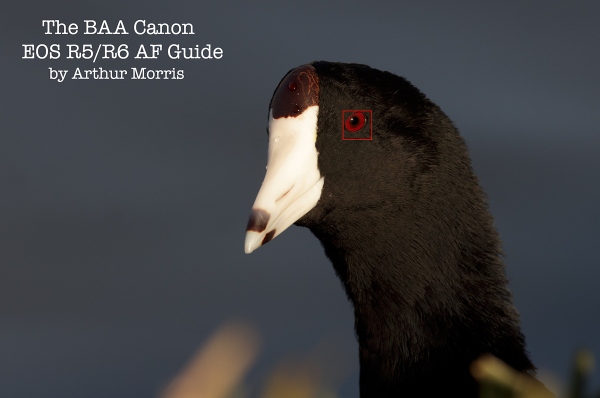

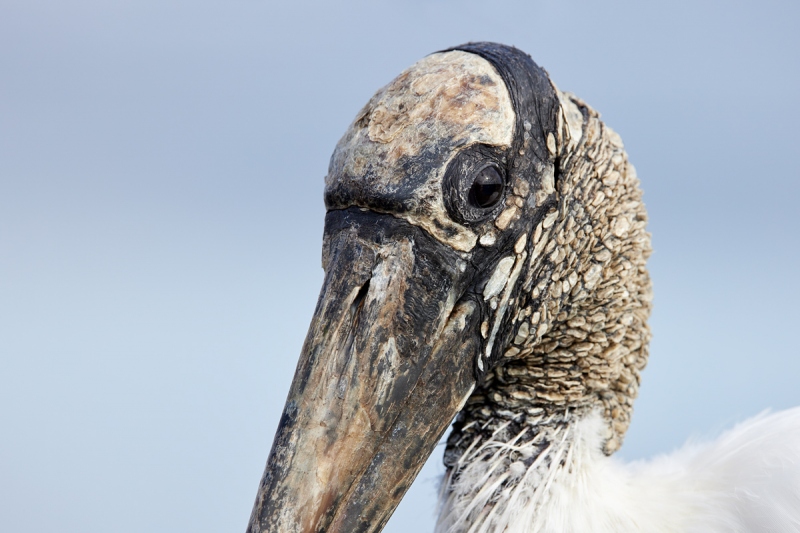
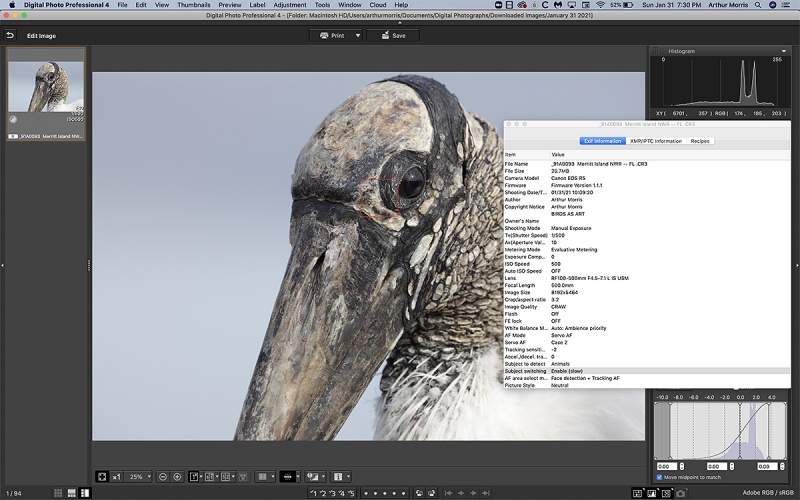
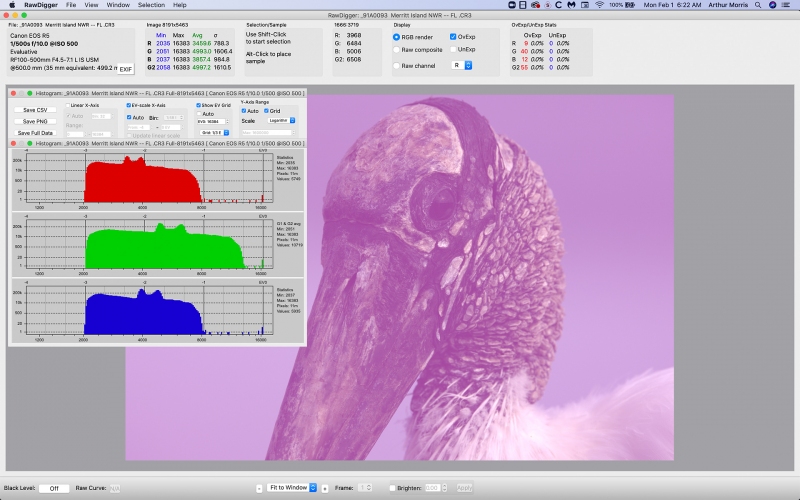
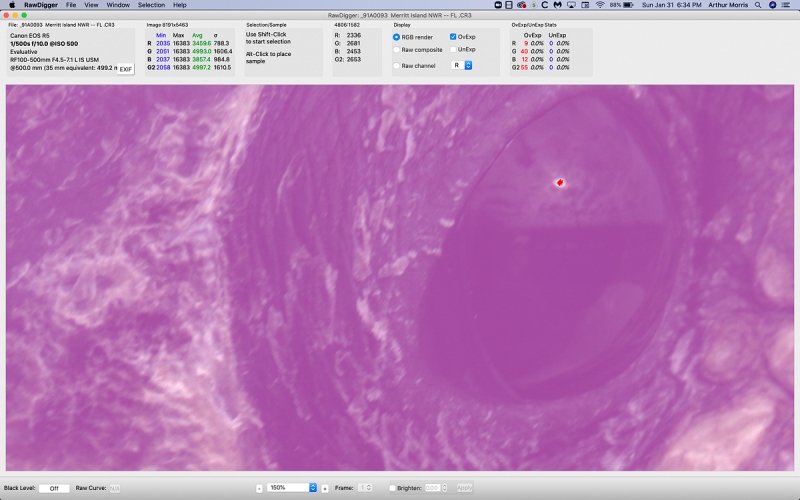













My most embarrassing moment yet when photographing came a couple of years back when shooting my daughter’s high school symphonic band. I had been photographing them for several years doing the marching band as well as the “formal” picture when they did their annual spring concert. We had to change venues and this year we were in the “crapatorium” (school auditorium) and not in our usual beautiful theater where I was always in the balcony. So I had to bring a ladder to go right in the middle of maybe 300 parents, in front of 100 kids and the band director.
OK, so I had done this before. However for whatever reason I was on total auto-pilot and after a weekend earlier of shooting, thought I had plenty of enough batteries. Well, things were great as I arrived way earlier then usual to get set up, my meter readings done, etc. Never a thought to the batteries… I took some pics in warmups and then we started..
I grabbed my ladder, set it up right in the middle, moving quickly as our band director hates me taking more than a minute of time to get set. Mind you I changed batteries just before I decided to start thinking I should make sure I have enough power…
I got up on the ladder, and NO GO! I checked everything… The battery that I THOUGHT had TWO bars….gave up the ghost as I stupidly realized I FORGOT TO CHARGE THE BATTERIES!
So, ok, I figured with three different bands that night I could still charge up and take the next two. Nope, again, NO GO because our director thought it was unfair if I could not do all three.
DANG was I embarrassed! Fortunately most parents actually felt bad for me, but I will never forget to CHARGE MY BATTERIES before a major shoot!
Shooting a stunning leopard on a termite mound, fill flash, gorgeous sunset in the background.
Once in a lifetime shots….then discover that Everything shot in small JPG!! This was on 1Dx2, and I am still struggling to discover how that setting came about: up to that point in the day everything was full size raw, and the change was obviously accidental.
Been there, done that 🙂
with love, artie
The only mistake made was claiming to have set the camera wrong. Actually, you were so inspired by Jim Brandenburg and his “Chased by the Light” project that you decided to take one image only of each subject. Great project.
Why hasn’t this thread achieved a record response? My own worst mistake was arriving in San Diego in 1999, driving immediately to Tijuana Slough Refuge, immediately getting on what for me was a brand new, very different hummingbird posing atop a pretty cactus at eye level, and shooting what seemed like more than a roll of nice shots, before realizing I hadn’t loaded any film. Got lots of nice images later in a three or four week trip, but never another California hummer.
See my ‘film-not-winding” stories in the comments section of Tuesday’s blog 🙂
What was the hummer?
with love, artie
The best up-close cheetah kill of my life. I was so excited I shot the whole thing 5 stops overexposed.
Mike
Everybody messes up. I remember going on a whale watch about 35 years ago. It was a chilly Spring day as we set out from Boston for the hour-long trip to Stellwagen Bank. At the time, my primary camera was my Canon A-1, complete with motor drive, my secondary body an FTb. The battery on the A-1 was getting weak, but since those silver oxide beauties were expensive (about $20 in today’s money) I didn’t swap it out for the new one in my bag. After traveling to the area where the whales were, the ship cut it’s engines and we drifted for about a minute. I was lucky enough to have a spot right at the rail at the bow of the ship and since the crew had announce that there were whales close by the boat I had a short lens on the A-1, motor drive set to High. Two adult humpbacks and a baby rose about 30 feet right in front of me – I brought the camera to my eye, focused and squeezed the shutter for a burst – nothing! The weak battery would not work in the chilly sea air! Frantically, I tore open my bag, grabbed the (loaded) FTb and put the correct lens on it – about a 15-20 second operation – but it was too late. I got off a couple of shots but I had watched the best shot of the day slip away thought the viewfinder because of my error. In the intervening years I have been on a couple more whale watches but never again was presented with an opportunity like the “one that got away”.
Seconds often matter in nature and wildlife photography 🙂
with love, a
Artie you definitely want to update your camera to the latest firmware 1.2. According to your exif info your running the older version there have been several improvements including some not mentioned in the info.
I would also check to make sure your lens firmware has been updated.
Canon has been really proactive with updates with another coming this month. Possibly with a shutter click option or frame rate choices for electronic shutter.
Thanks, Joe. Will do. How do you update the lens firmware???
with love, a
Artie same process as the camera body. After you download the firmware to a card go to 5th page yellow menu select firmware then another window opens and allows you to select camera,lens or battery grip.
Joe. The camera update worked out very well. There has not been a lens firmware update …
thanks with love, a
Artie we all have a story to tell.
I was given a location to shoot some amazing sunrises so I thought why not go, I took my camera out put in a fresh battery about 3am made sure my pack was all set, loaded my car and headed out for a 3 hour drive oneway. I get there and it was calm and with excitement got out my gear tripod etc. went to the pack and OH MY I FORGOT to put my camera body in my pack after changing the battery….yep it was sitting on the counter when I drove back home. Duh!
With love Bob
NOW I check and re check….lol
Thank you for sharing that R5 story, makes me feel a little better for doing the same thing. I also took several hundred pictures of the ground while trying to figure out why my shutter wasn’t working….. I was absolutely sure I had changed it to mechanical mode. Looking forward to purchasing your guide!
I remember in 2001 shooting at the Loxahatchee Wildlife Preserve in Florida. I opened the back of my Nikon F4 and saw the film sitting there — I had forgotten to rewind it! ( One of the many reasons I love digital and would never want to go back to shooting film!)